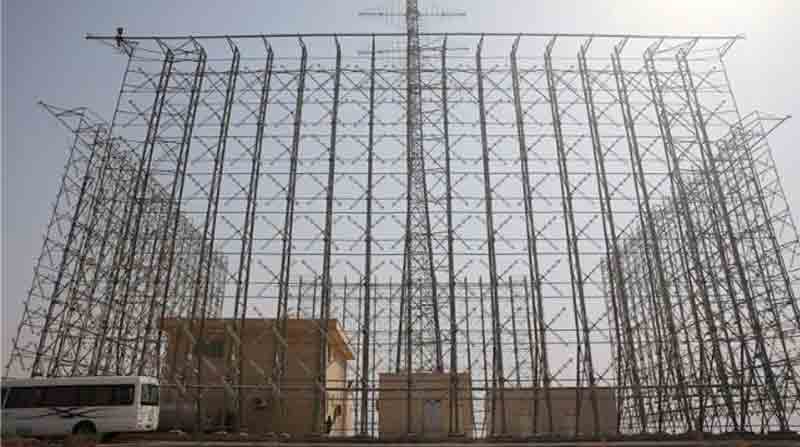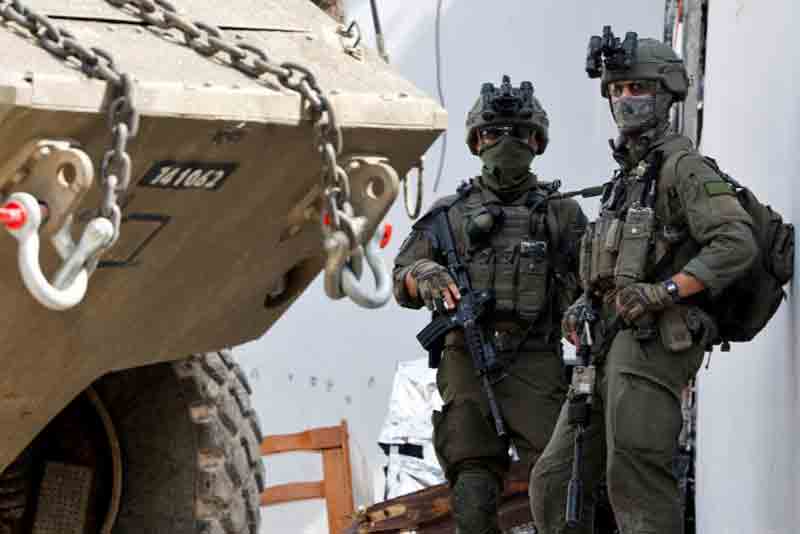Iran’s Islamic Revolutionary Guard Corps Aerospace Force is progressively enhancing its network of “Ghadir” over-the-horizon early warning radars, with new construction sites emerging in the northwest region near Tabriz and along the Persian Gulf coastline.
Recent analyses by open-source intelligence experts utilizing satellite imagery from Google Maps and Google Earth have brought these developments to light, indicating Tehran’s persistent efforts to strengthen its air defense capabilities against potential threats, particularly from the United States and Israel.
These radars, which are engineered to identify incoming strike aircraft, cruise missiles, and ballistic missiles from considerable distances, mark a substantial advancement in Iran‘s military infrastructure.
As tensions continue to rise in the Middle East, these installations may alter the strategic considerations for any nation contemplating military action against Iran, while also prompting inquiries regarding their actual capabilities and the wider implications for the region.
The “Ghadir” radar system has been a part of Iran’s defense framework since its debut in 2011 during the Great Prophet 6 military exercises, with the IRGC officially incorporating it into service in 2012.
Developed domestically by the IRGC Aerospace Force’s Self-Sufficiency Jihad Organization, the Ghadir is a phased-array, three-dimensional radar boasting a claimed detection range of 1,100 kilometers (over 680 miles) for ballistic missiles and 600 kilometers (approximately 373 miles) for aircraft.
Iranian officials, including Brigadier General Farzad Esmaili, the former commander of the IRGC’s air defense force, have asserted that the system can track stealth aircraft, cruise missiles, and even small drones, due to its capability to resonate frequencies and monitor targets at altitudes of up to 300 kilometers.
In a 2014 statement to the press in Tehran, Esmaili highlighted the system’s robustness, stating that it “can withstand electronic warfare” and has a “minimal chance” of being detected or neutralized by anti-radar missiles.
This integration of long-range detection capabilities and reported resistance to jamming is fundamental to Iran’s strategy for safeguarding its airspace.
What distinguishes the Ghadir from many traditional radar systems is its over-the-horizon functionality, enabling it to identify threats that lie beyond the Earth’s curvature. In contrast to line-of-sight radars, which are constrained by geographical features and distance, over-the-horizon systems utilize radio waves reflected off the ionosphere to detect targets located hundreds or even thousands of miles away.
The Ghadir operates within the high-frequency spectrum, likely around a 6-meter wavelength, which enhances its capacity to detect low-flying or stealthy objects that may evade detection by shorter-wavelength systems. For instance, the United States utilizes the AN/FPS-118 over-the-horizon radar as part of its Ballistic Missile Early Warning System, capable of identifying targets at distances greater than 3,000 kilometers.
Russia’s Rezonans-N, another over-the-horizon radar system, offers a comparable range and has been exported to countries such as Iran, where it complements indigenous systems like the Ghadir.
Although Iran’s radar may not achieve the extensive range of its American equivalent, its design seems specifically aimed at addressing particular threats—especially stealth aircraft like the F-35 and low-altitude cruise missiles that adversaries in the region might deploy.
The technical prowess of the Ghadir is noteworthy, but its deployment sites provide insight into Iran’s strategic focus. The newly established location northwest of Tabriz, identified by analysts at coordinates 38.756697, 44.955930, is situated in West Azerbaijan Province, a rugged and mountainous region near the borders with Turkey and Iraq.
This strategic positioning takes advantage of the area’s high elevation—some sites exceeding 2,200 meters—to enhance the radar’s line-of-sight capabilities, while also allowing it to monitor potential threats from the west, a likely approach for U.S. or Israeli airstrikes.
Along the Persian Gulf, various Ghadir installations are strategically positioned along the coastline, safeguarding crucial shipping routes and oil facilities that serve as both economic lifelines and potential targets. These southern locations, identified through satellite images shared by OSINT researchers such as @obretix on X, are designed to monitor naval threats, including aircraft launched from carriers or Tomahawk missiles fired from U.S. warships operating in the Gulf.
Collectively, these sites create a defensive perimeter that integrates with Iran’s extensive air defense system, which features Russian-supplied S-300 systems alongside domestically manufactured missile batteries.
The selection of these locations by Iran is deliberate. The northwest region provides a natural mountainous barrier, making it difficult for enemy aircraft to penetrate at low altitudes, while the Persian Gulf coastline serves as a critical chokepoint for maritime traffic and a focal point for military operations. Historically, Iran has regarded both areas as susceptible to attacks.
During the Iran-Iraq War in the 1980s, Iraqi forces penetrated deep into western Iran, targeting urban centers and infrastructure. More recently, Israel’s airstrikes in October 2024 on Iranian military sites—including two Ghadir radar installations near the Iraqi border—highlighted the tangible threats faced by these facilities.
As noted in posts on X by @sentdefender, these strikes temporarily compromised Iran’s ability to detect ballistic missile threats from the West, emphasizing the significance of the radars as high-value targets. In response, Tehran has expedited construction efforts, indicating a commitment to fortifying its defenses.
The open-source intelligence community has been instrumental in revealing these developments. By utilizing commercially available satellite imagery, analysts have accurately identified specific coordinates and monitored construction activities, frequently sharing their insights on platforms like X.
The issue of who gains from these disclosures is intricate. Some theorize that the release of specific coordinates—down to latitude and longitude—might be a strategic move by nations opposed to Iran, aimed at facilitating targeting in a potential future conflict.
Conversely, others suggest that this reflects Iran’s self-assurance and its intent to demonstrate its technological capabilities as a form of deterrence. Regardless, the rise of open-source intelligence (OSINT) has revolutionized modern warfare, transforming publicly available tools such as Google Earth into strategically significant assets.
The Ghadir radars, beyond their direct military function, have wider implications for the Middle East. Iran’s neighboring countries are observing closely. Turkey, with its advanced military and NATO-aligned air force, may view the northwest radar as a counterbalance to its regional aspirations, especially amid tensions regarding Kurdish militias near their border.
Iraq, positioned between Iran and the U.S., risks becoming further embroiled in any escalation, particularly if American forces in the region are seen as a threat. Along the Gulf, Saudi Arabia and the United Arab Emirates—both equipped with U.S.-manufactured Patriot systems and F-35 aircraft—might perceive Iran’s radar network as a move towards asserting dominance over the vital waterways of the region. The potential for an arms race is significant, as these nations enhance their defenses in response.
From an economic perspective, the radars prompt inquiries about Iran’s allocation of resources. Faced with severe U.S. sanctions, Tehran has struggled to finance its military goals. Nevertheless, the Islamic Revolutionary Guard Corps (IRGC), which controls substantial portions of the economy through front companies and illicit channels, has prioritized initiatives like the Ghadir project.
A report from the Council on Foreign Relations in 2024 highlights that the IRGC’s financial network generates billions, often circumventing sanctions to acquire technology and materials. The domestic development of radar systems—promoted as a testament to self-sufficiency—could potentially lessen dependence on foreign suppliers such as Russia. However, some analysts believe that Iran has modified Russian designs, including the Rezonans-N, to develop the Ghadir radar.
What might an attack on these radar systems entail? Historical precedents provide insight. In 2007, Israel’s Operation Orchard successfully targeted a Syrian nuclear reactor, employing F-15s and electronic warfare tactics to incapacitate Syrian radar systems.
More recently, strikes on Iran in October 2024 involved F-35 stealth fighters, precision-guided munitions, and possibly drones, as indicated by satellite imagery analysis from the Institute for the Study of War. A similar operation against the Ghadir sites could commence with cyberattacks aimed at disrupting command and control systems, followed by low-flying F-35s that remain undetected until the last moment.
High-altitude B-2 bombers could utilize standoff weapons like the Joint Air-to-Surface Standoff Missile, while drones could jam radar frequencies. Although the Ghadir’s elevated positions and extended range might provide Iran with a few additional minutes of warning, its fixed locations—now widely recognized—render it susceptible to preemptive attacks.
Iran’s expansion of its radar capabilities signals a nation preparing for potential conflict, yet it also highlights the limitations of its strategic approach. The Ghadir radar represents a significant technological advancement, designed to detect sophisticated threats over extensive distances. However, its success is contingent upon effective integration with missile defense systems and fighter jets—areas where Iran trails behind the capabilities of the U.S. and Israel.
In contrast to the United States’ interconnected Aegis system, which synchronizes radars, naval vessels, and satellites in real-time, Iran’s defense network remains fragmented and dependent on manual coordination. While these radars may provide a deterrent against minor attacks, their effectiveness against a determined adversary equipped with superior stealth and electronic warfare capabilities is questionable.
Additionally, the psychological implications are twofold: although Iran seeks to project strength, each new radar installation also becomes a target, raising the stakes in any potential confrontation.
The introduction of the Ghadir radar exemplifies Iran’s broader military transformation, merging innovation with a stance of defiance. For the United States, it serves as a reminder that Tehran’s military capabilities are advancing, even amid external pressures.
For the surrounding region, this development could act as a trigger for instability, prompting rival nations to recalibrate their military strategies. Whether these radars genuinely alter the balance of power or merely attract increased scrutiny will depend on Iran’s ability to safeguard them.
As satellite imagery continues to reveal military secrets, the global community observes a high-stakes scenario where technology, geography, and geopolitics intersect. Will this provide Iran with a crucial advantage, or will it merely serve as another flashpoint in an already unstable Middle East? Only time, and possibly the next conflict, will provide clarity.
Discover more from Defence Talks | Defense News Hub, Military Updates, Security Insights
Subscribe to get the latest posts sent to your email.





